Did you know that over 300 years of Spanish colonization left a lasting mark on Filipino fashion? From the elegant Baro’t Saya to the iconic Maria Clara gown, the influence of Spanish attire is deeply woven into the fabric of Filipino culture.
Back in the 16th century, Spain was at the forefront of global fashion trends. Its intricate designs and luxurious fabrics quickly made their way to the Philippines, blending with local traditions. This fusion created unique styles that are still celebrated today.
The cultural exchange between Spain and the Philippines went beyond just clothing. It shaped the way Filipinos express themselves through fashion, blending heritage with modern trends. Today, this influence is visible in both formal and casual attire, showcasing a rich history of style and elegance.
In this article, we’ll explore how Spanish clothing styles have shaped Filipino fashion, from historical garments to contemporary designs. Discover how these influences continue to inspire and define Filipino identity.
Key Takeaways
- Spanish fashion deeply influenced Filipino clothing styles over centuries.
- The Baro’t Saya and Maria Clara gown are iconic examples of this blend.
- Cultural exchange between Spain and the Philippines shaped modern trends.
- Spanish-inspired designs remain relevant in both formal and casual wear.
- Filipino fashion continues to honor its heritage while embracing modern influences.
Introduction: Bridging Spanish and Filipino Fashion
From intricate lace to refined designs, Spanish influences have left an indelible mark on Filipino attire. This cultural exchange began centuries ago, blending elegance with local traditions to create a unique fashion identity.
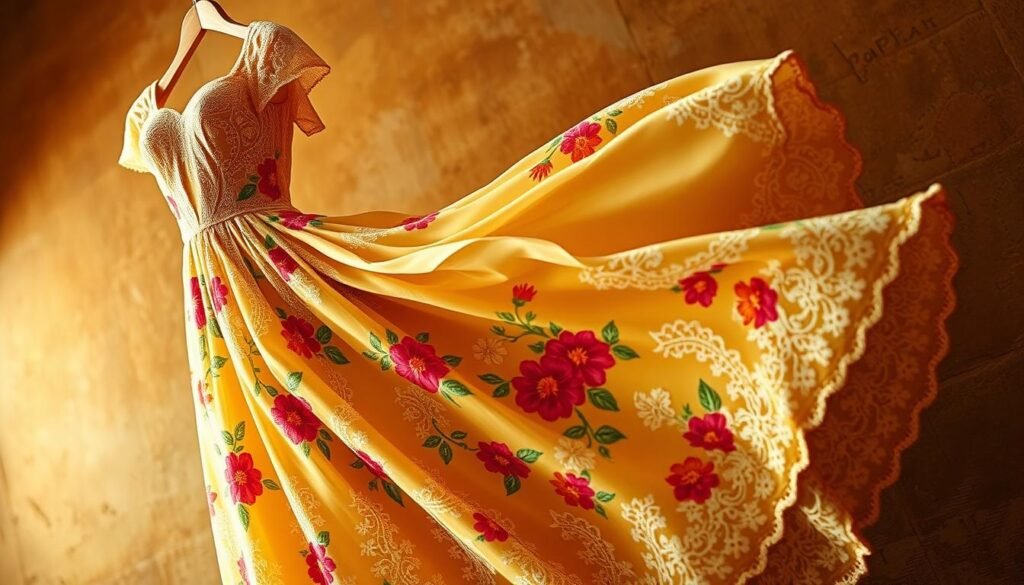
Historical Context
The roots of this influence trace back to Spain’s Renaissance period. During this time, intricate lace and detailed dressmaking were prominent. These elements found their way to the Philippines, shaping the way women dressed.
One iconic example is the Baro’t Saya, a traditional Filipino dress. Its delicate lace details and high neckline reflect Spanish elegance. This blend of styles became a symbol of cultural fusion.
Modern Relevance
Today, these influences remain visible in both formal and casual wear. Designers often incorporate lace and refined designs into modern outfits. This keeps the heritage alive while adapting to contemporary trends.
Women’s clothing, in particular, continues to honor this legacy. From elegant gowns to everyday dresses, the Spanish touch is unmistakable. This enduring influence highlights the timeless appeal of these styles.
- Spanish elegance shaped Filipino fashion through intricate lace and refined designs.
- Traditional garments like the Baro’t Saya showcase this cultural blend.
- Modern designers continue to draw inspiration from these historical elements.
- The influence is particularly evident in women’s clothing and accessories.
Historical Overview of Spanish Clothing Styles
The 16th century marked a turning point in European fashion, with Spain leading the way in elegance and innovation. During this period, luxurious dresses and intricate designs became symbols of power and sophistication. The Renaissance brought new techniques in fabric use and embroidery, shaping the way people dressed.
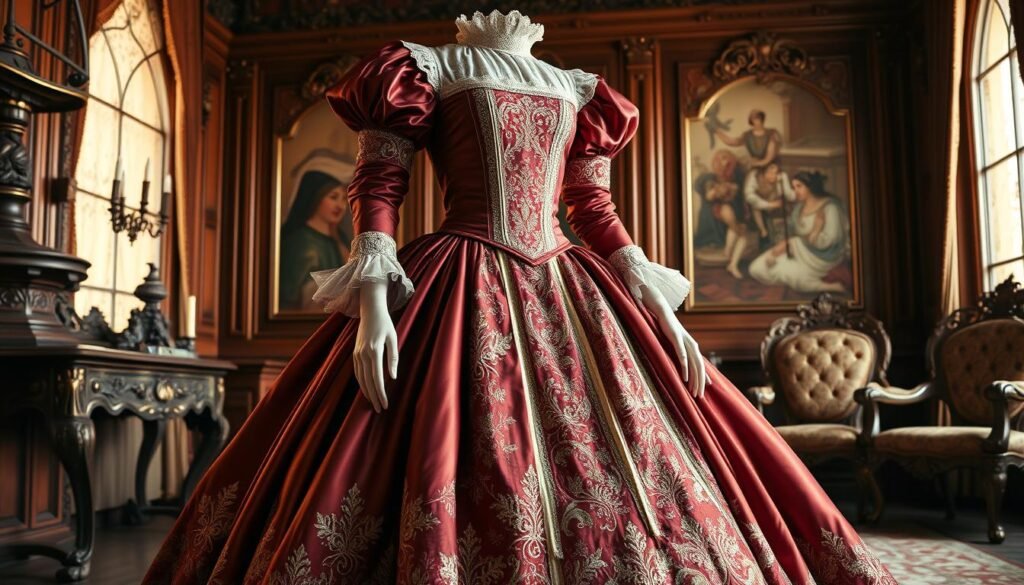
Women’s attire, in particular, reflected both status and artistry. Corsets and farthingales were popular, creating structured silhouettes. Elaborate neck adornments and detailed embroidery added a touch of grandeur to every outfit. These garments were not just functional but also works of art.
16th Century Elegance
In the 16th century, traditional clothing evolved with distinctive details. High collars and ruffled sleeves became hallmarks of elegance. Women’s dresses often featured rich fabrics like silk and velvet, adorned with gold or silver threads. This era set the stage for later fashion influences.
Renaissance Innovations
The Renaissance introduced innovative techniques in fabric and design. Embroidery became more intricate, showcasing floral and geometric patterns. Women’s attire emphasized both comfort and style, with flowing skirts and fitted bodices. These innovations continue to inspire modern fashion trends.
- Luxurious dresses and structured silhouettes defined 16th-century fashion.
- Elaborate neck adornments and detailed embroidery added elegance.
- Women’s attire reflected both power and artistry during this period.
- Renaissance innovations in fabric and design shaped future trends.
Spanish Cultural Traditions in Fashion
Spain’s rich culture has long influenced fashion, blending ceremonial elegance with everyday style. From the iconic mantilla to intricate shoulder adornments, these traditions reveal a deep connection to both heritage and identity.
One of the most recognizable elements is the mantilla, a lace or silk veil worn by women during religious ceremonies. This piece symbolizes grace and modesty, reflecting the values of Spanish society. Similarly, detailed shoulder embellishments and high neck designs add a touch of sophistication to traditional attire.
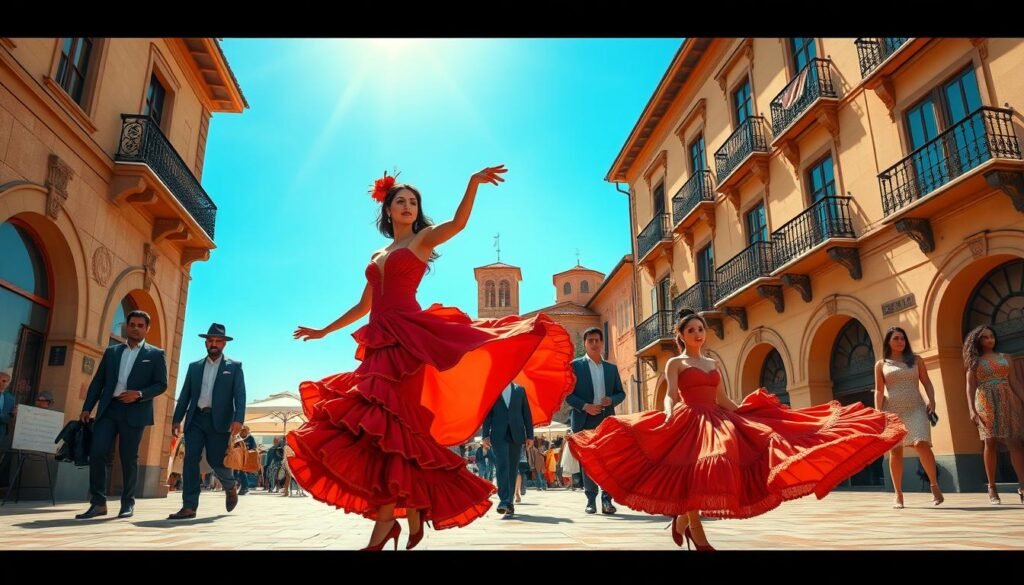
Historical customs also introduced sleeveless designs, which were both practical and stylish. These elements were not just about aesthetics but also represented regional pride. For example, the traje de flamenca, a traditional dress, showcases vibrant patterns and flounces that celebrate Andalusian heritage.
“Fashion is a reflection of identity, and in Spain, it’s a celebration of culture and tradition.”
Today, these influences continue to inspire modern designs. Filipino fashion, in particular, has adapted these elements, blending them with local traditions. This fusion creates a unique style that honors both Spanish and Filipino heritage.
| Element | Significance | Modern Adaptation |
|---|---|---|
| Mantilla | Symbol of grace and modesty | Used in bridal and ceremonial wear |
| Shoulder Adornments | Represents sophistication | Featured in formal gowns |
| Sleeveless Designs | Practical and stylish | Common in casual and summer wear |
From ceremonial garments to everyday attire, Spanish fashion traditions remain a testament to the enduring power of culture. These elements not only define identity but also inspire global trends, showcasing the timeless appeal of Spanish style.
Evolution of Spanish Clothing: From Moorish Influences to Modern Trends
The Moorish legacy in Spain brought a wave of artistic and cultural innovations to traditional dress. From 711 to 1492, their contributions introduced rich embroideries, jewels, and heavy girdles, adding opulence to garments. This blend of styles created a unique fashion identity that continues to inspire.
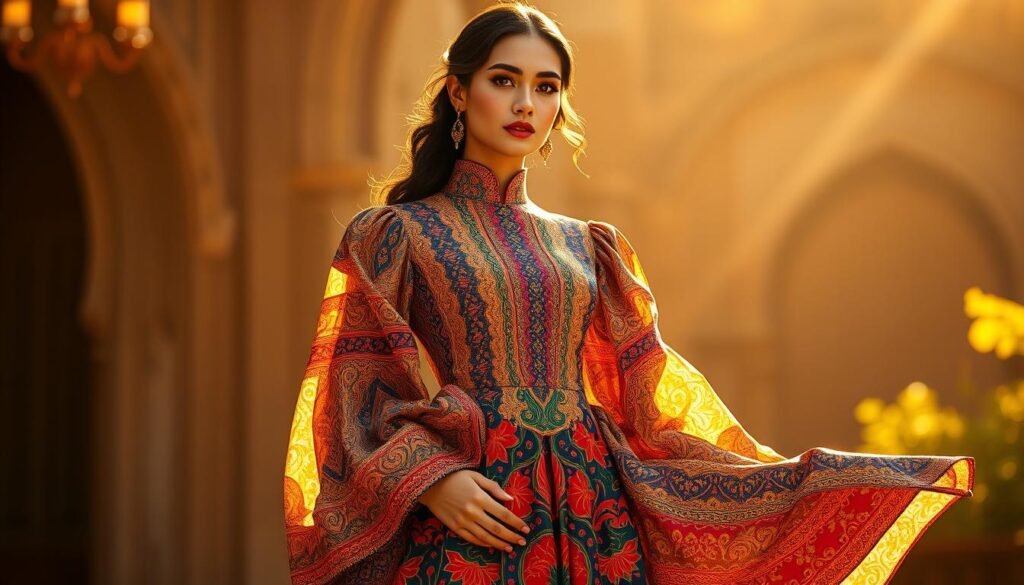
Moorish Impact on Traditional Dress
Moorish artistry reshaped the way women dressed, emphasizing intricate details and lavish embellishments. Ruffles and ornamentation, once simple, evolved into elaborate designs. These elements became hallmarks of elegance, blending functionality with beauty.
Over the centuries, these influences transitioned into modern adaptations. The flamenco dress, for example, retains its traditional roots while embracing contemporary trends. Its vibrant colors and flowing ruffles showcase the enduring appeal of Moorish-inspired design.
Today, this cultural interplay continues to inspire designers. The fusion of elegant form and practicality remains a key feature in both formal and casual wear. From ceremonial attire to everyday outfits, the Moorish legacy lives on, celebrating a rich history of style and innovation.
The Lasting Impact of Spanish Clothing on Filipino Fashion
The fusion of Iberian Peninsula aesthetics with Filipino traditions has created a timeless fashion legacy. Over centuries, elements like intricate necklines and detailed embroidery have become defining features of Filipino attire. These designs bridge continents, showcasing a rich history of cultural exchange.
One standout feature is the emphasis on neck detailing. High collars and ornate embellishments, inspired by Spanish styles, add elegance to traditional garments. For the modern woman, these elements blend heritage with contemporary trends, creating a unique fashion identity.
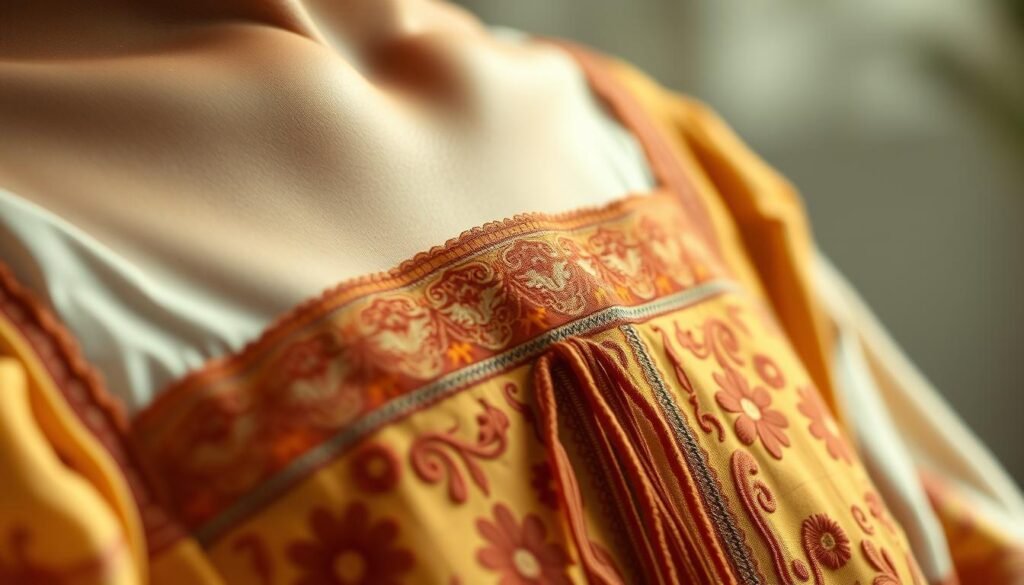
Embroidery also plays a significant role. Techniques from Spain were adapted to local tastes, resulting in vibrant patterns that tell stories of culture and tradition. This craftsmanship continues to inspire designers, ensuring these elements remain relevant in modern fashion.
The integration of these styles reflects a deep respect for history. From formal gowns to everyday wear, the influence of the Iberian Peninsula is unmistakable. This enduring connection highlights the power of cultural exchange in shaping identity and style.
Adapting Spanish Dress Elements in Filipino Attires
The vibrant energy of flamenco has left a lasting impression on Filipino fashion, blending dramatic silhouettes with local traditions. This influence is particularly evident in the way dress elements have been reinterpreted to suit modern tastes. From cultural performances to everyday wear, the flamenco spirit continues to inspire.
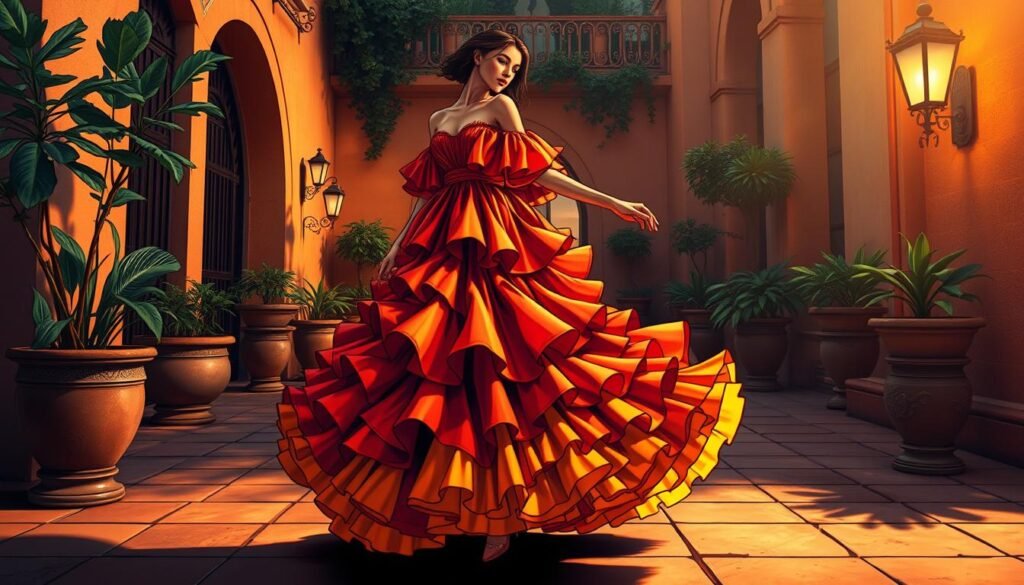
Flamenco Influences
Flamenco’s signature ruffles and bold designs have found their way into Filipino attire. These elements add flair to both costumes and casual outfits, creating a unique blend of elegance and vibrancy. The flowing skirt designs, for instance, reflect the dynamic movement of flamenco dancers.
Embroidery also plays a key role in this adaptation. Intricate patterns inspired by flamenco are often incorporated into modern dress designs. This craftsmanship highlights the artistry behind each piece, making it a standout feature in both formal and everyday wear.
Accessories, such as head adornments, further enhance the flamenco-inspired look. These details add a touch of sophistication, making the attire suitable for special occasions. The fusion of these elements showcases the enduring appeal of Spanish fashion in Filipino culture.
- Flamenco’s ruffles and dramatic silhouettes add flair to modern costumes.
- Embroidery techniques bring intricate patterns to contemporary designs.
- Skirt designs reflect the dynamic energy of flamenco dance.
- Head accessories contribute to the distinct, elegant style.
From cultural performances to everyday outfits, the influence of flamenco remains strong. This adaptation not only honors tradition but also celebrates the creativity of modern Filipino fashion.
Iconic Spanish and Filipino Accessory Trends
Accessories have always played a pivotal role in defining cultural identity, and the fusion of Spanish and Filipino styles is no exception. From ceremonial pieces to everyday adornments, these accessories tell stories of heritage and creativity.
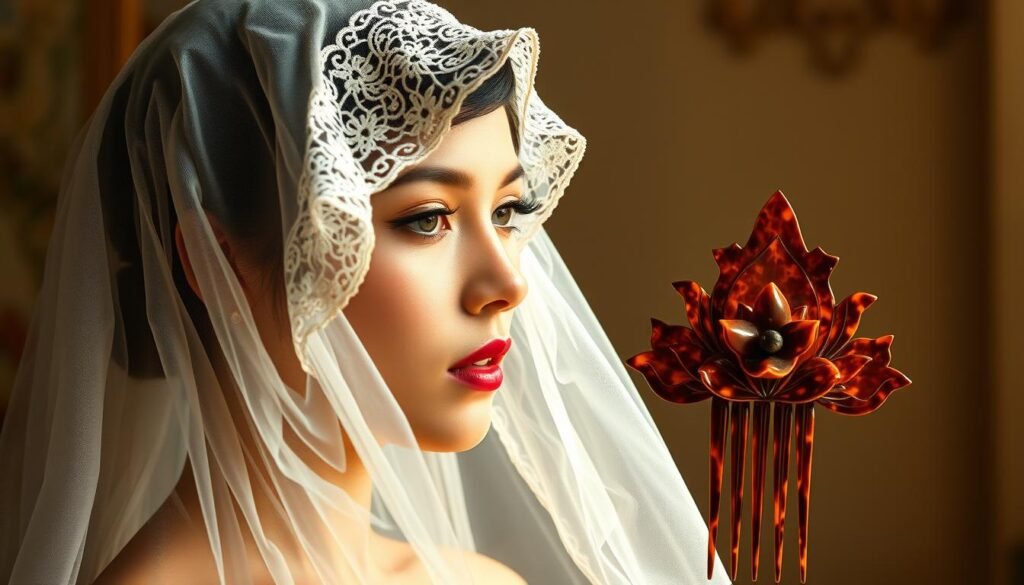
Mantilla and Peineta
The mantilla, a delicate lace or silk veil, is a timeless symbol of Spanish elegance. Often paired with a decorative peineta, it adds grace to any special event. In the Philippines, this combination has been adapted for weddings and religious ceremonies, blending tradition with modern flair.
These accessories are not just about aesthetics. They represent cultural pride and continuity. The intricate lacework of the mantilla and the ornate designs of the peineta showcase the artistry of both cultures.
Other Decorative Adornments
Beyond the mantilla, other accessories highlight the rich exchange between Spain and the Philippines. Colorful neck adornments, for instance, are a staple in festive attire. They often feature vibrant patterns and intricate embroidery, reflecting the craftsmanship of both traditions.
In modern fashion, these elements are reimagined to suit contemporary tastes. A blouse with lace details or a business outfit with subtle Spanish-inspired accents can make a statement. This blend of old and new keeps the heritage alive while embracing innovation.
- The mantilla and peineta are iconic symbols of Spanish elegance, adapted for Filipino celebrations.
- Neck adornments showcase intricate craftsmanship, blending Spanish and Filipino styles.
- Modern designs incorporate traditional elements, making them relevant for today’s fashion.
- Accessories play a key role in culturally significant events, honoring heritage and creativity.
From weddings to festivals, these accessories continue to inspire. They remind us of the enduring connection between Spain and the Philippines, celebrated through fashion and artistry.
Regional Influences: Andalusian, Basque, and Catalonian Styles
Spain’s regional styles, from Andalusia to Catalonia, have shaped global fashion narratives. Each region brings unique elements to the table, blending tradition with vibrant creativity. These influences are not just local but have resonated worldwide, inspiring designers and fashion enthusiasts alike.
Andalusian fashion is known for its lively colors and flowing silhouettes. The dress designs often feature ruffles and bold patterns, perfect for fiesta celebrations. Women’s attire includes intricate shoulder embellishments, while men’s outfits often highlight tailored vests.
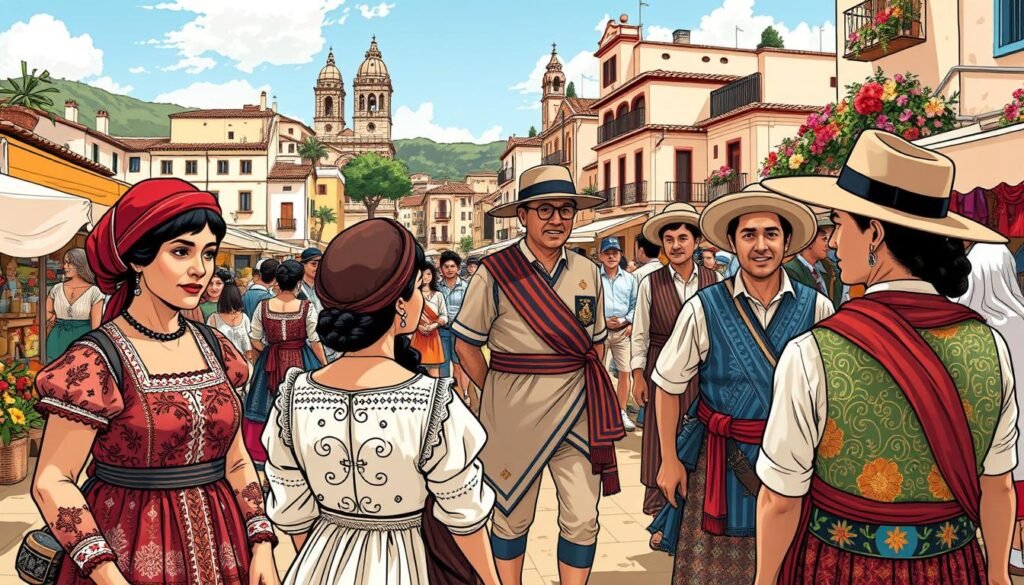
In the Basque region, the focus is on simplicity and functionality. Men’s clothing includes classic vests paired with neutral tones, reflecting a timeless elegance. Women’s dresses often incorporate clean lines and minimalistic details, making them versatile for both formal and casual wear.
Catalonian style, on the other hand, is a blend of tradition and modernity. The long dress is a staple, often adorned with intricate embroidery. These designs are perfect for both fiesta events and beach outings, showcasing the region’s adaptability.
- Andalusian fashion features vibrant colors and ruffled dresses for festive occasions.
- Basque style emphasizes simplicity, with tailored vests for men and clean-lined dresses for women.
- Catalonian designs blend tradition with modernity, often showcasing long dresses with detailed embroidery.
These regional styles have left a lasting impact on global fashion. From the runways to everyday wear, the influence of Andalusian, Basque, and Catalonian traditions continues to inspire. Their unique elements remind us of the rich cultural heritage that shapes our world of style.
Signature Pieces in Spanish Clothing and Their Modern Interpretations
The traje de flamenca stands as a timeless symbol of cultural elegance and artistry. Originating in Andalusia, this iconic spanish dress has evolved from traditional attire to a global fashion statement. Its vibrant colors, ruffled designs, and intricate details make it a centerpiece of Spanish heritage.
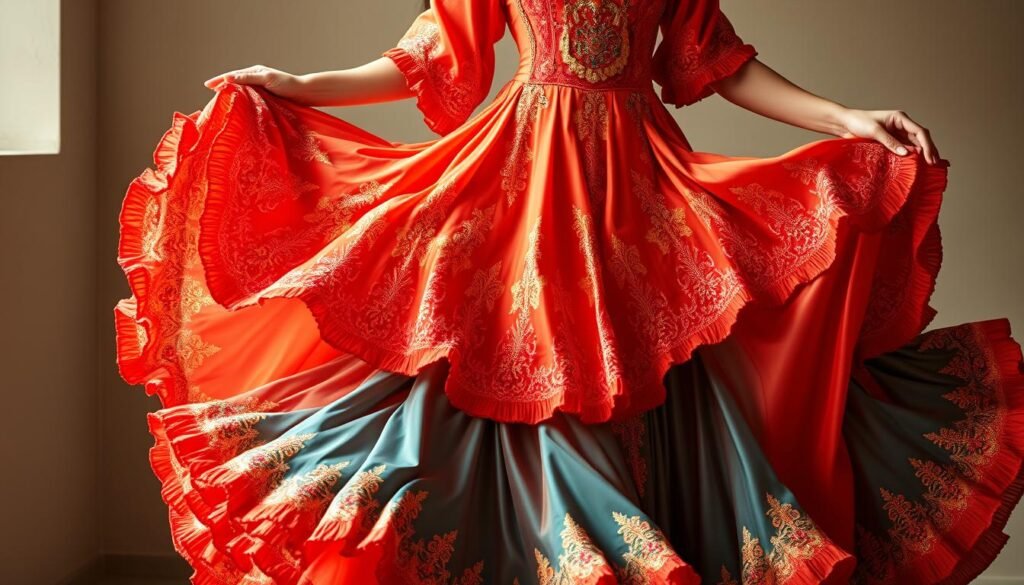
Traje de Flamenca and its Evolution
Originally worn by women during festivals, the traje de flamenca has undergone significant transformations. In the 1960s, its dress silhouette became shorter, reflecting changing trends. Today, modern interpretations feature varied sleeve lengths, bold patterns, and innovative cuts, making it suitable for both event wear and casual outings.
One of its defining features is the emphasis on neck detailing. High collars and ornate embellishments draw inspiration from the iberian peninsula’s rich design traditions. These elements add sophistication, ensuring the traje de flamenca remains a symbol of elegance.
Modern designers have reimagined this traditional clothing for contemporary audiences. By blending heritage with modern aesthetics, they create pieces that honor the past while embracing the future. For example, a shirt paired with flamenco-inspired ruffles can transform an everyday outfit into a statement of style.
- The traje de flamenca is a signature piece in Spanish fashion, celebrated for its vibrant designs and cultural significance.
- Its evolution reflects a balance between preserving heritage and adapting to modern trends.
- Neck detailing and Iberian design elements remain central to its enduring appeal.
- Modern interpretations make this traditional attire versatile for today’s events and casual wear.
From festivals to runways, the traje de flamenca continues to inspire. Its ability to bridge tradition and innovation ensures its place in the global fashion narrative. Discover more about the rich history of cultural influences in Filipino fashion and how it intertwines with global trends.
Impact of Spanish Clothing on Business and Casual Wear in the Philippines
The blend of traditional and modern styles has reshaped Filipino fashion in both business and casual wear. Spanish-inspired designs have become a staple, offering a unique fusion of elegance and practicality. From formal events to everyday outfits, these influences are unmistakable.
In business attire, elements like shoulder detailing and structured silhouettes draw from Spanish aesthetics. These features add a polished look, making them ideal for professional settings. For example, a tailored dress with intricate embroidery can elevate a woman’s wardrobe, blending heritage with modern functionality.
Wedding and formal wear also reflect this cultural exchange. Traditional Spanish garments inspire modern wedding gowns, featuring lace and high collars. These designs create a timeless elegance, perfect for special occasions. The result is a refined style that honors both Filipino and Spanish traditions.
Casual wear has embraced the vibrancy of flamenco influences. Ruffled skirts and bold patterns add flair to everyday outfits. These elements make casual attire both stylish and culturally rich. Accessories like head adornments further enhance the look, creating a cohesive style.
- Spanish-inspired shoulder detailing adds sophistication to business attire.
- Wedding gowns feature lace and high collars, blending tradition with modern elegance.
- Flamenco influences bring vibrancy to casual wear, making it both stylish and unique.
- Accessories like head adornments complete the polished look.
From boardrooms to weddings, Spanish-inspired designs continue to shape Filipino fashion. This fusion not only celebrates cultural heritage but also creates a versatile and refined style. Discover more about the rich history of these influences in traditional Spanish fashion.
Modern Spanish Fashion on the Global Stage
Spain’s fashion legacy continues to inspire designers worldwide, blending tradition with modern innovation. From iconic brands to cutting-edge designs, Spanish fashion remains a prominent part of the global stage. This influence is evident in the works of renowned designers who have shaped trends today.
Influential Designers
Designers like Cristóbal Balenciaga and Paco Rabanne have redefined fashion with their unique approaches. Balenciaga’s structured silhouettes and Rabanne’s metallic designs showcase the perfect blend of heritage and modernity. Their creations often feature intricate neck detailing, a signature element of Spanish style.
Modern Spanish fashion integrates traditional craftsmanship with contemporary trends. Brands like Zara and Loewe have leveraged their heritage to create globally appealing collections. Their success is amplified through digital platforms, where the web plays a crucial role in promoting these designs to a wider audience.
Here’s a look at how Spanish designers have influenced global fashion:
| Designer | Contribution | Global Impact |
|---|---|---|
| Cristóbal Balenciaga | Revolutionized silhouettes with structured designs | Inspired high fashion worldwide |
| Paco Rabanne | Introduced metallic and futuristic elements | Pioneered avant-garde fashion |
| Jonathan Anderson (Loewe) | Blended traditional craftsmanship with modern aesthetics | Transformed the brand into a global icon |
Spanish fashion continues to set trends, with designers embracing both heritage and innovation. From the runway to everyday wear, their influence is undeniable. Explore more about the rich history of fashion in the Philippines through this ancient Filipino script.
Traditional Spanish Garments and Special Event Attire
Traditional garments hold a timeless appeal, especially when reserved for weddings and special events. These pieces are more than just attire; they are symbols of cultural heritage and identity. From the intricate mantilla to the vibrant flamenco dress, each piece tells a story of tradition and artistry.
In weddings, the mantilla, a delicate lace veil, is a staple. It adds elegance and modesty to the bride’s ensemble. This traditional clothing is often paired with a decorative comb, enhancing its beauty. The flamenco dress, with its ruffles and bold patterns, is another iconic costume used in celebrations, particularly in Andalusia.
These garments serve both decorative and functional purposes. The mantilla, for example, is not just a beautiful accessory but also a symbol of grace. Similarly, the flamenco dress allows for dynamic movement, making it perfect for dance performances during festivals.
Modern designers have reinterpreted these classic designs, blending them with contemporary trends. For instance, a wedding gown might feature a high neckline inspired by the mantilla but with a modern twist. This fusion keeps the heritage alive while appealing to today’s fashion sensibilities.
- Traditional garments like the mantilla and flamenco dress are central to cultural celebrations.
- These pieces serve both decorative and functional roles in special events.
- Modern interpretations blend traditional clothing with contemporary design elements.
- The enduring legacy of these garments continues to inspire global fashion trends.
From weddings to festivals, these garments remain a testament to the rich cultural exchange between Spain and the Philippines. Explore more about the influence of traditional Spanish garments on modern fashion.
Cross-Cultural Fusion: Textile Techniques and Embroidery
The intricate fusion of textile techniques and embroidery showcases the seamless blend of innovation and tradition in fashion. From delicate lace to elaborate ruffles, these elements highlight the artistry behind every dress. This craftsmanship is a testament to the rich cultural exchange between regions, particularly the Iberian Peninsula.
Art of Lace and Ruffles
Lace-making is a centuries-old tradition that continues to inspire modern designs. The intricate patterns and delicate threads add elegance to any long dress. Ruffles, on the other hand, bring movement and flair, making them a favorite for festive attire.
These techniques are not just decorative but also functional. For example, lace embellishments on a shirt can elevate its style, while ruffles add volume and drama to a dress. The combination of these elements creates a unique blend of heritage and modernity.
Innovation Meets Tradition
Modern designers are reinterpreting traditional methods to suit contemporary tastes. Techniques like embroidery and lace-making are being adapted for today’s fashion, ensuring their relevance in the digital age. The web plays a crucial role in showcasing these innovations to a global audience.
Region-specific techniques, such as those from the Iberian Peninsula, are also gaining recognition. These methods are being incorporated into modern garments, blending tradition with innovation. This fusion keeps the heritage alive while appealing to today’s fashion sensibilities.
| Technique | Traditional Use | Modern Adaptation |
|---|---|---|
| Lace-making | Used in ceremonial attire like the mantilla | Featured in casual and formal wear |
| Ruffles | Common in festive and dance costumes | Added to everyday outfits for a stylish touch |
| Embroidery | Symbolized cultural identity | Used in contemporary designs for added elegance |
From traditional garments to modern interpretations, these techniques continue to shape the world of fashion. They remind us of the enduring connection between culture and creativity, celebrated through every stitch and pattern.
Technological Advancements in Spanish Textile Production
Innovations in textile technology have revolutionized the way traditional garments are produced, blending heritage with modern efficiency. These advancements have streamlined production techniques while preserving the intricate details that define iconic styles.
Modern technology has significantly improved the creation of delicate dress elements. Techniques like 3D printing allow for precise control over fabric composition, ensuring high-quality results. This innovation reduces waste and enhances customization, making it ideal for both casual and formal wear.
Traditional details, such as sleeveless designs, are now easier to maintain thanks to advanced machinery. These methods ensure that heritage techniques are not lost but rather enhanced by contemporary practices. The result is a seamless blend of old and new, appealing to modern consumers.
These advancements have also expanded the versatility of fabrics. High-quality materials are now suitable for a range of occasions, from beach outings to fiesta celebrations. This adaptability ensures that traditional garments remain relevant in today’s fashion landscape.
Spanish textile companies have led the way in sustainability, developing machinery that reduces water and energy consumption. This focus on eco-friendly practices not only lowers costs but also minimizes environmental impact. Learn more about these innovations in Spanish textile technology.
- Modern technology enhances the production of intricate dress elements.
- Advanced machinery preserves traditional details like sleeveless designs.
- High-quality fabrics are now versatile for beach and fiesta attire.
- Sustainability practices reduce environmental impact and production costs.
Sustainability in Fashion: Leveraging Spanish Heritage
Sustainability has become a driving force in the fashion industry, blending heritage with eco-conscious innovation. Today, designers are repurposing traditional techniques to create garments that honor culture while reducing environmental impact. This approach not only preserves artistry but also aligns with modern consumer values.
Sustainable Practices
Spanish fashion brands are leading the way in sustainable practices. For example, Zara aims to use 100% sustainable fabrics by 2025, with 93% of its cotton already recycled or sustainable. Similarly, Ecoalf’s “Upcycling the Oceans” project transforms ocean plastic into high-quality garments, showcasing how innovation can address environmental challenges.
Traditional elements like neck detailing are being preserved even in eco-friendly designs. This ensures that the aesthetic appeal of heritage garments remains intact. By integrating these details, designers create pieces that are both timeless and sustainable.
Digital platforms play a crucial role in promoting these initiatives. Through the web, brands educate consumers about their sustainable practices, fostering a deeper connection between heritage and modern values. This approach not only enhances transparency but also encourages responsible consumerism.
Here’s a look at how Spanish brands are embracing sustainability:
| Brand | Initiative | Impact |
|---|---|---|
| Zara | 100% sustainable fabrics by 2025 | 93% recycled cotton usage |
| Ecoalf | Upcycling ocean plastic | Reduces marine waste |
| Thinking Mu | Organic materials and fair trade | Promotes ethical labor practices |
These efforts highlight the importance of sustainability in business practices. By combining tradition with innovation, Spanish fashion continues to set trends while addressing global environmental concerns. Learn more about the intersection of sustainability and fashion in this comprehensive study.
Conclusion
The fusion of historical artistry and modern innovation has left a lasting impact on Filipino fashion. From intricate neck details to flowing ruffles, these elements define the unique style that blends tradition with contemporary trends.
Both women’s and men’s attire have benefited from this cultural exchange. Traditional costumes have evolved, becoming versatile pieces for modern wardrobes. This blend is particularly evident in wedding attire and festive event wear, where heritage meets innovation.
The influence of Spain continues to shape Filipino fashion, ensuring that cultural artifacts remain relevant. This enduring connection highlights the power of culture in creating timeless dress designs. Discover more about the rich history of Spanish clothing styles and their global impact.
FAQ
How did Spanish clothing styles influence Filipino fashion?
The styles introduced during the colonial period, such as lace, embroidery, and ruffles, became integrated into traditional Filipino attire, creating a unique blend of cultures.
What are some iconic Spanish garments still relevant today?
The mantilla, traje de flamenca, and peineta remain iconic, often seen in weddings, celebrations, and cultural events.
How has Moorish culture impacted Spanish dress?
Moorish influences introduced intricate patterns, vibrant colors, and flowing silhouettes, which are still evident in traditional designs like the flamenco dress.
What role does lace play in Spanish fashion?
Lace is a hallmark of elegance, often used in mantillas, veils, and decorative elements on dresses, symbolizing sophistication and tradition.
How are Spanish clothing elements adapted in Filipino attires?
Elements like ruffles, embroidery, and lace are incorporated into Filipino garments such as the baro’t saya, blending Spanish flair with local aesthetics.
What are some key accessories in Spanish fashion?
The mantilla, peineta, and decorative combs are essential, often paired with traditional dresses for a complete look during special events.
How do regional styles like Andalusian and Basque influence fashion?
Andalusian styles emphasize vibrant colors and ruffles, while Basque designs focus on simplicity and structure, both contributing to the diversity of Spanish fashion.
What is the significance of the traje de flamenca?
This dress, originally worn by flamenco dancers, has evolved into a symbol of cultural pride, often featured in festivals and celebrations.
How has Spanish fashion impacted global trends?
Designers like Cristóbal Balenciaga and Manuel Pertegaz have brought Spanish aesthetics to the global stage, influencing modern fashion with their innovative designs.
What sustainable practices are rooted in Spanish textile production?
Traditional techniques like hand-weaving and natural dyeing are being revived, promoting eco-friendly practices while preserving cultural heritage.
Source Links
- Fashion and clothing in the Philippines
- The Evolution of Modern Filipiniana: A Brief History of Philippine Fas
- The Cultural Significance of Traditional Filipino Clothing – Festive Pinoy
- Culture of the Philippines
- The Filipino Salakot
- Spanish clothing culture: Fashion across Spain
- Spanish Dresses – Traditional Spanish Clothing
- Spanish Traditional Garb: Origins & Influence
- Spanish Cultural Influences in Fashion Explained
- 5 Traditional Spanish Outfits to Discover
- Spanish Traditional Clothing | DonQuijote
- Fashion in Spain Today: How to NOT Look Like a Tourist
- Culture of Spain – history, people, clothing, traditions, women, beliefs, food, customs, family
- The Spanish Influence on Filipino Culture and Language
- What does it mean to be Filipino? Celebrating Filipino Heritage Month Through Our Clothing and Textiles
- Philippines Traditional Clothes: Timeless Cultural Treasures
- The Evolution of Modern Filipiniana: A Brief History of Philippine Fas
- Filipiniana Dresses And How They’ve Changed Throughout History
- Top Philippine Fashion Trends | Newport World Resorts
- Filipino Fashion Spotlight: Top 12 Styles That Make a Statement
- The Origin of Modern Filipino Men’s Fashion — The Dabbler Effect
- Culture of Spain
- Spain Culture : Language, Religion, Food
- Traje de flamenca
- Spanish selection: 15 of the best brands to know from Spain
- How Velázquez and Goya Inspired Balenciaga’s Daring Haute Couture
- Philippines – Culture, Diversity, Traditions | Britannica
- Global Fashion Trends and Their Impact on Business Strategies | LCCA
- The Evolution of Filipiniana
- Spanish Influence on Global Fashion: A Stylish Discourse
- Spanish Designers Making Waves in the Global Fashion Scene
- Fashion in Spain Today: How to NOT Look Like a Tourist
- SPAIN AND ITS CULTURE | Textile Magazine, Textile News, Apparel News, Fashion News
- Traditional Spanish Children’s Clothes | La Coqueta Kids
- Weaving words for textile museums: the development of the linked SILKNOW thesaurus – npj Heritage Science
- Tradition in Action-Traditional Costume Innovations
- Textile Technology Innovations: Shaping the Future of Fabric
- Mexico’s Textile Industry: Boom, Innovation, & Opportunity (2024 Update)
- The Role Of Sustainability In Spanish Fashion: Leading Brands And Their Initiatives
- Sustainable Fashion Trends in the Spanish Market
- Day of the Dead in Spanish: Mexican Culture and Traditions

